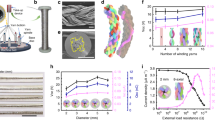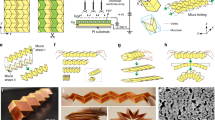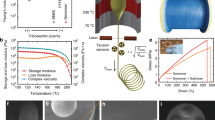Abstract
Triboelectric energy harvesting has been applied to various fields, from large-scale power generation to small electronics. Triboelectric energy is generated when certain materials come into frictional contact, e.g., static electricity from rubbing a shoe on a carpet. In particular, textile-based triboelectric energy-harvesting technologies are one of the most promising approaches because they are not only flexible, light, and comfortable but also wearable. Most previous textile-based triboelectric generators (TEGs) generate energy by vertically pressing and rubbing something. However, we propose a corrugated textile-based triboelectric generator (CT-TEG) that can generate energy by stretching. Moreover, the CT-TEG is sewn into a corrugated structure that contains an effective air gap without additional spacers. The resulting CT-TEG can generate considerable energy from various deformations, not only by pressing and rubbing but also by stretching. The maximum output performances of the CT-TEG can reach up to 28.13 V and 2.71 μA with stretching and releasing motions. Additionally, we demonstrate the generation of sufficient energy from various activities of a human body to power about 54 LEDs. These results demonstrate the potential application of CT-TEGs for self-powered systems.
Similar content being viewed by others
Introduction
Energy-harvesting technologies obtain electric energy from the ambient environment, e.g., solar1, wind2, thermal3, and mechanical energy4,5. Energy harvesting has emerged as one of the most promising solutions for the rapidly increasing energy crises and global warming issues. Wearable energy-harvesting technologies are attractive for reducing the size and weight of electronic devices. Wearable energy sources should be flexible, lightweight, and ease to use. Wearable devices typically use conventional electrochemical batteries as energy sources. However, a battery does not provide energy consistently because it has a limited lifetime and is not durable. Recently, simple, highly efficient, and cost-effective triboelectric generators (TEGs) have been developed6,7,8,9,10,11,12,13,14,15,16,17,18. Among them, fiber/textile-type TEG19,20,21,22,23,24,25,26,27,28 technologies provide an energy source for self-powered devices, e.g., wearable devices, electronic skin, bio-medical devices, and portable electronics, because of their lightweight, flexibility, and comfort. In principle, triboelectric energy-harvesting technologies operate by contact electrification and electrostatic induction6. As our body movements, e.g., stretching, pressing, and rubbing, are frequent and easily accessible mechanical-energy sources, textile-based TEGs integrated into clothing can effectively convert this mechanical energy into electrical energy. Most previously developed textile-based TEGs have generated energy based on pressing and rubbing motions19,20,21,22,23.
In this study, we propose a corrugated textile-based triboelectric generator (CT-TEG), which generates energy not only by pressing and rubbing but also by stretching. The CT-TEG is sewn into a corrugated structure using the textile characteristics. As a result, the output voltage of the triboelectric generator 28.13 V, 119.1 V, 11.2 V at stretching, pressing and rubbing motions, respectively. Also, the CT-TEG generated energy under mechanical deformation of wrist, arm and foot and light up 54 light emitting diodes connected in series. The proposed CT-TEG is an extremely promising power supply for wearable devices.
Results
Structure of corrugated textile-based triboelectric generator
Figure 1(a) shows the design of the corrugated textile-based triboelectric generator (CT-TEG). The CT-TEG consists of the following two layers: silk with a woven conductive textile on the top and Si-rubber with a knitted conductive textile on the bottom. The SEM images of woven conductive textile and knitted conductive textile shown in Fig. 1(b,c), respectively. The top layer is composed of a corrugated structure that is sewn to the bottom layer (Supplementary Fig. S1). Such a corrugated structure enhances the level of effective strain applied in the silk layer and drives the shape of the generator to the original state upon release of the applied force. The corrugated structure can achieve reversible contact (stretched) and non-contact (released) states, as demonstrated in Supplementary Fig. S2. The CT-TEG can be stretched up to 120%. Figure 1(d) is the SEM image of the silk textile as the top layer. The surface of the silk textile has roughness, which leads to efficient friction. The average diameters of the silk textile were 16 μm.
Working mechanism of corrugated textile-based triboelectric generator
The power-generation mechanism of the CT-TEG is illustrated in Fig. 2. The CT-TEG enables energy generation by a conjunction of triboelectrification and electrostatic induction. The silk and Si-rubber are used as positive and negative triboelectric active materials. Since the silk and Si-rubber have different electron-attracting abilities, a surface charge is transferred when the two are brought into contact. In the initial state, without any motion, no charge is transferred (Fig. 2(a)). Once the CT-TEG is stretched, the TEG brings the silk and Si-rubber into full contact (Fig. 2(b)). Any motion will lead to a contact or separation between the silk and Si-rubber. The silk is charged positively and the Si-rubber is charged negatively because of their triboelectric characteristics.
When the two triboelectric materials are brought into contact, electrons move from the silk to Si-rubber because Si-rubber has a higher surface-electron affinity than silk. Consequently, in the CT-TEG, there is a net negative charge on the Si-rubber and a net positive charge on the silk26. Removing the external force causes a separation. Electrons flow from the Si-rubber-coated conductive textile electrode to the silk/conductive textile electrode (Fig. 2(c)). When the silk and Si-rubber are separated by the maximum distance, an electrical equilibrium is formed (Fig. 2(d)). When external force is applied to bring the silk and Si-rubber into contact, it causes electrons to flow from the silk/conductive textile electrode to the Si-rubber-coated conductive textile electrode (Fig. 2(e)). With the stretching, pressing, and rubbing motions, the surfaces of the silk and Si-rubber come into contact and rub against each other; thus, triboelectric charges are generated and distributed over the surface.
Electrical performance of corrugated textile-based triboelectric generator
Open-circuit voltage and short-circuit current were measured for the CT-TEG under stretching, pressing and rubbing states. In stretching and releasing motions, the CT-TEG produced an open-circuit voltage of 28.13 V and a short-circuit current of 2.71 μA, as shown in Fig. 3(a,b), respectively. To investigate the effect of stretching frequency, it was varied from 2 to 4 Hz (Supplementary Fig. S3). It was evident that the voltages increased gradually with stretching frequency. At each frequency, the voltage values were obtained as follows: 7.45 V (2 Hz), 10.26 V (3 Hz), and 22.45 V (4 Hz). Under a vertical pressing force of 1 kgf, the CT-TEG exhibited a repeatable and consistent voltage of 119.1 V and a current of 26.1 μA (Fig. 3(c,d)). Additionally, the output voltage and current increased with the external pressing force. (Supplementary Fig. S4) Under a pressing force of 0.2 kgf to 0.6 kgf, the voltage increased from 23.9 V to 60.5 V. This can be because more friction and deformation of silk and Si-rubber under higher external mechanical force increases the amount of generated triboelectric charges. The CT-TEG sliding mode operates at a frequency of 2 Hz; the electrical output shows 11.2 V and 0.84 μA (Fig. 3(e,f)). Thus, the corrugated structure of the CT-TEG generates power regardless of the motion.
Figure 4 shows the output performance of the CT-TEG for stretching motion. The maximum output voltage increased with load resistance, whereas the maximum voltage decreased (Fig. 4(a)). Accordingly, the instantaneous output power calculated using W = I2 peak × R was 16.6 μW/cm2 for a load resistance of 40 Ω, as shown Fig. 4(b). Figure 4(c) shows the output results vs. corrugated density. It is observed that the triboelectric output voltage increases with the corrugated density. Typically, a larger contact area produces more triboelectricity13. The charging of capacitors with different capacitance values has been studied experimentally, as shown in Fig. 4(d). It was observed that in the CT-TEG, the 1 μF capacitor charged to 114 mV in 20 s under periodic stretching and releasing. Additionally, the 2 μF capacitor charged to 99 mV. Therefore, the proposed CT-TEG is sufficient as an energy harvesting unit for a power source that employs stretching and releasing motions.
To investigate the capability of the CT-TEG as a power source, we considered different parts of the human body. Here, the movement of the wrist, knee, and foot are the most important mechanical-energy sources supplied by the human body. As shown in Fig. 5(a), a stretchable textile-based CT-TEG is placed over the wrist joint. The CT-TEG stretches when the wrist bends and relaxes when the wrist straightens, generating output voltage signals. The triboelectric voltage generated by the wrist joints is about 6.8 V. Figure 5(b) shows a corrugated textile-based CT-TEG attached to the side of the body to harvest energy from the arm rubbing. The output voltage is about 8.1 V. Figure 5(c) shows the corrugated textile-based CT-TEG generating energy from footsteps. Its output voltage is about 110.1 V, which is capable of lighting up about 54 light-emitting diodes (LEDs) (Fig. 5(d)). Therefore, the proposed corrugated structure of the textile-based TEG has several advantages, e.g., harvesting different kinds of mechanical energy from the human body. It effectively converts ambient mechanical energy into electricity, which can be used to drive small electronics such as wearable devices.
Discussion
In this paper, we propose a new corrugated structure for a textile-based triboelectric generator that can be attached to the surface of the human body to harvest mechanical energy. The fabric of the presented triboelectric generator is sewn into a corrugated structure that achieves an effective air gap without additional spacers. The maximum output voltages of the triboelectric generator are 28.13 V, 119.1 V and 11.2 V for stretching, pressing, and rubbing motions, respectively. Additionally, we demonstrated the generation of sufficient energy from various activities of the human body to operate 54 LED bulbs. It is expected that the stretchable and high-performing corrugated textile-based TEG can be widely used for wearable energy-harvesting systems.
Methods
Fabrication of the CT-TEG
A commercially available knitted conductive textile (Ag-plated nylon, DEV-10070) and a woven conductive textile (Sn/Cu/Ag-plated nylon, DEV-10056) were used for fabricating the CT-TEG. The top layer consisted of silk with the woven conductive textile attached through backstitch. The production of Si-rubber involves mixing the EcoFlex0050 solution in a 1:1 ratio for 15 min using a glass rod. The bottom layer is composed of Si-rubber coated on the knitted conductive textile substrate, which is kept at room temperature for 3 h. The top layer is composed of a corrugated stretchable textile sewn onto the bottom layer. Narrow air gaps were created in the CT-TEG between the top and bottom layers. The size of CT-TEG is 5 × 3 cm2.
Characterization and measurement of the CT-TEG
The morphologies of the silk textile were examined through SEM(JSM 840-A, JEOL. Ltd, Japan). A pushing tester (JIPT-100, JUNIL Tech. Ltd, Korea) was used to apply forces to the CT-TEG. The triboelectric performance was measured using an oscilloscope (MSO9104A, Agilent Tech., USA) and SMU (B2911A, Agilent Tech., USA).
Additional Information
How to cite this article: Choi, A. Y. et al. Corrugated Textile based Triboelectric Generator for Wearable Energy Harvesting. Sci. Rep. 7, 45583; doi: 10.1038/srep45583 (2017).
Publisher's note: Springer Nature remains neutral with regard to jurisdictional claims in published maps and institutional affiliations.
References
Sharma, M., Chauhan, A., Vaish, R. & Chauhan, V. S. Finite element analysis on solar energy harvesting using ferroelectric polymer. Sol. Energy 115, 722–732 (2015).
Seol, M. L. et al. Vertically stacked thin triboelectric nanogenerator for wind energy harvesting. Nano Energy 14, 201–208 (2014).
Yang, Y. et al. Pyroelectric nanogenerators for harvesting thermoelectric energy. Nano Lett. 12, 2833–2838 (2012).
Zhu, G. et al. Toward large-scale energy harvesting by a nanoparticle-enhanced triboelectric nanogenerator. Nano Lett. 13, 847–853 (2013).
Cha, S. N. et al. Sound-driven piezoelectric nanowire-based nanogenerators. Adv. Mater. 22, 4726–4730 (2010).
Fan, F. R., Tian, Z. Q. & Wang, Z. L. Flexible triboelectric generator. Nano Energy 1, 328–334 (2012).
Wang, S., Lin, L. & Whang, Z. L. Nanoscale triboelectric-effect-enabled energy conversion for sustainably powering portable electronics. Nano Lett. 12, 6339–6346 (2012).
Wang, S. et al. Sliding-triboelectric nanogenerators based on in-plane charge-separation mechanism. Nano Lett. 13, 2226–2233 (2013).
Yang, Y. et al. A single-electrode based triboelectric nanogenerator as self-powered tracking system. Adv. Mater. 25, 6594–6601 (2013).
Xie, Y. et al. Multi-layered disk triboelectric nanogenerator for harvesting hydropower. Nano Energy 6, 129–136 (2014).
Yang, W. et al. Harvesting energy from the natural vibration of human walking. ACS Nano 7, 11317– 11324 (2013).
Chen, J. et al. Harmonic-resonator-based triboelectric nanogenerator as a sustainable power source and a self-powered active vibration sensor. Adv. Mater. 25, 6094–6099 (2013).
Fan, F. R. et al. Transparent triboelectric nanogenerators and self-powered pressure sensors based on micropatterned plastic films. Nano Lett. 12, 3109–3114 (2012).
Zhu, G. et al. Triboelectric-generator-driven pulse electrodeposition for micropatterning. Nano Lett. 12, 4960–4965 (2012).
Zhong, J. W. et al. Finger typing driven triboelectric nanogenerator and its use for instantaneously lighting up LEDs. Nano Energy 2, 491–497(2012).
Lee, S. et al. Triboelectric nanogenerator for harvesting pendulum oscillation energy Nano Energy 2, 1113–1120 (2013).
Jing, Q. et al. Self-powered triboelectric velocity sensor for dual-mode sensing of rectified linear and rotary motions. Nano Energy 10, 305–312 (2014).
Zhang, H. et al. Triboelectric nanogenerator for harvesting vibration energy in full space and as self-powered acceleration sensor. Adv. Funct. Mater. 24, 1401–1407 (2014).
Zhou, T. et al. Woven structured triboelectric nanogenerator for wearable devices. ACS Appl. Mater. Inter. 6, 14695–14701 (2014).
Pu, X. et al. A self-charging power unit by integration of a textile triboelectric nanogenerator and a flexible lithium-ion battery for wearable electronics. Adv. Mater. 27, 2472–2478 (2015).
Ko, Y. H., Nagaraju, G. & Yu, J. S. Multi-stacked PDMS-based triboelectric generators with conductive textile for efficient energy harvesting. RSC Adv. 5, 6437–6442 (2015).
Seung, W. et al. Nanopatterned textile-based wearable triboelectric nanogenerator. ACS Nano 9, 3501–3509 (2015).
Lee, S. et al. Triboelectric energy harvester based on wearable textile platforms employing various surface morphologies. Nano Energy 12, 410–418 (2015).
Jung, S., Lee, J., Hyeon, T., Lee, M. & Kim, D. H. Fabric-based integrated energy devices for wearable activity monitors. Adv. Mater. 26, 6329–6334 (2014).
Huang, T. et al. Human walking-driven wearable all-fiber triboelectric nanogenerator containing electrospun polyvinylidene fluoride piezoelectric nanofibers. Nano Energy 14, 226–235 (2015).
Wang, Z. L. Triboelectric nanogenerators as new energy technology for self-powered systems and as active mechanical and chemical sensors. ACS Nano 7, 9533–9557 (2013).
Wen, Z. et al. Self-powered textile for wearable electronics by hybridizing fiber-shaped nanogenerators, Science Advances 2, 1–8 (2016).
Lee, J. H. et al. All-in-one energy harvesting and storage devices. J. Mater. Chem. A 4, 7983–7999 (2016).
Acknowledgements
This research was supported by the MSIP(Ministry of Science, ICT and Future Planning), Korea, under the ITRC (Information Technology Research Center) support program (IITP-2017-R0992-17-1021) supervised by the IITP(Institute for Information & communications Technology Promotion).
Author information
Authors and Affiliations
Contributions
A.Y.C. and Y.T.K. conceived the idea and wrote the main manuscript; C.J.L. fabricated materials for experiments; J.W.P. and D.G.K. analyzed generator’s performance. All authors discussed the results and commented on the manuscript.
Corresponding author
Ethics declarations
Competing interests
The authors declare no competing financial interests.
Supplementary information
Rights and permissions
This work is licensed under a Creative Commons Attribution 4.0 International License. The images or other third party material in this article are included in the article’s Creative Commons license, unless indicated otherwise in the credit line; if the material is not included under the Creative Commons license, users will need to obtain permission from the license holder to reproduce the material. To view a copy of this license, visit http://creativecommons.org/licenses/by/4.0/
About this article
Cite this article
Choi, A., Lee, C., Park, J. et al. Corrugated Textile based Triboelectric Generator for Wearable Energy Harvesting. Sci Rep 7, 45583 (2017). https://doi.org/10.1038/srep45583
Received:
Accepted:
Published:
DOI: https://doi.org/10.1038/srep45583
This article is cited by
-
Programming mechanics in knitted materials, stitch by stitch
Nature Communications (2024)
-
Research Progress of Fabrics with Different Geometric Structures for Triboelectric Nanogenerators in Flexible and Wearable Electronics
Advanced Fiber Materials (2023)
-
Recent progress in silk fibroin-based flexible electronics
Microsystems & Nanoengineering (2021)
-
A laser ablated graphene-based flexible self-powered pressure sensor for human gestures and finger pulse monitoring
Nano Research (2019)
Comments
By submitting a comment you agree to abide by our Terms and Community Guidelines. If you find something abusive or that does not comply with our terms or guidelines please flag it as inappropriate.








